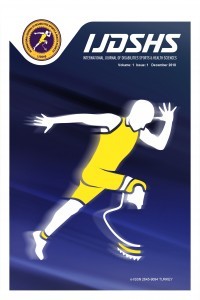Determination of Anthropometric Measurements and Nutritional Status of Wheelchair Basketball Players
Determination of Anthropometric Measurements and Nutritional Status of Wheelchair Basketball Players
Wheelchairs, Basketball, Anthropometry, Nutrition,
___
- Chung, E.A., Emmanuel, A.V. (2006). Gastrointestinal symptoms related to autonomic dysfunction following spinal cord injury. Prog Brain Res; 152:317-333.
- Close, G.L., Hamilton, D.L., Philp, A., Burke, L.M., Morton, J. (2016). New strategies in sport nutrition to increase exercise performance. Free Radic Biol Med; 98:144-58.
- Demirkan, E., Koz, M., Kutlu, M. (2010). The effects of dehydration on athletic performance and monitoring hydration levels. Spormetre The Journal of Physical Education and Sport Sciences; 8(3):81-92.
- Ersoy, G. (2004). Nutrition for Exercise and Athletes. Third edition. Turkey. Nobel Publication and Distribution.
- Eskici, G., Ersoy, G. (2016). An evaluation of wheelchair basketball players' nutritional status and nutritional knowledge levels. J Sports Med Phys Fitness; 56:259-68.
- Fink, H.H., Burgoon, L.A., Mikesky, A.E. (2006). Practional Applications in Sports Nutrition. Canada, Jones and Bartlett Publishers.
- Fletcher, GF., Landolfo, C., Niebauer, J., Ozemek, C., Arena, R., Lavie, CJ. (2018). Promoting physical activity and exercise: JACC health promotion series. J Am Coll Cardiol 2018;72(14):1622-1639.
- Foley, J.T., Lloyd, M., Turner, L., Temple, V.A. (2017). Body mass index and waist circumference of Latin American adult athletes with intellectual disability. Salud Publica Mex; 59:416-22.
- Geders, J.M., Gaing, A., Bauman, W.A., Korsten, M.A. (1995). The effect of cisapride on segmental colonic transit time in patients with spinal cord injury. Am J Gastroenterol; 90(2).
- Goosey-Tolfrey, V.L., Crosland, J. (2010). Nutritional practices of competitive British wheelchair games players. Adapt Phys Activ Q; 27(1):47-59.
- Grams, L., Garrido, G., Villacieros, J., Ferro, A. (2016). Marginal micronutrient intake in high performance male wheelchair basketball players: a dietary evaluation and the effects of nutritional advice. PLoS One; 11(7):e0157931.
- Harris, N., Rosenberg, A., Jangda, S., O’Brien, K., Gallagher, M.L. (2003). Prevalence of obesity in International Special Olympic athletes as determined by body mass index. JADA; 103:235-7.
- Hawley, J., Dennis, S.C., Noakes, T.D. (1994). Carbohydrate, fluid and electrolyte requirements of the soccer player: a review. Int J Sport Nutr; 3:221-236.
- Jeukendrup, A.E. (2017). Training the gut for athletes. Sports Med; 47:101-10.
- Jung, W., Yamasaki, M. (2009). Effect of pre-exercise carbohydrate ingestion on substrate consumption in persons with spinal cord injury. Spinal Cord; 47(6):464.
- Kreider, R.B., Wilborn, C.D., Taylor, L., Campbell, B., Almada, A.L., Collins, R., et al. (2010). ISSN exercise and sport nutrition review: Research and recommendations. J Int Soc Sports Nutr; 7:7.
- Krempien, J.L., Barr, S.I. (2011). Risk of nutrient inadequacies in elite Canadian athletes with spinal cord injury. Int J Sport Nutr Exerc Metab; 21(5):417-425.
- Lee, S.K., Posthauer, M.E., Dorner, B., Redovian, V., Maloney, M.J. (2006). Pressure ulcer healing with a concentrated, fortified, collagen protein hydrolysate supplement: a randomized controlled trial. Adv Skin Wound Care; 19(2):92-96.
- Liu, Y., Lee, DC., Li, Y., et al. (2019). Associations of resistance exercise with cardiovascular disease morbidity and mortality. Med Sci Sports Exerc;51(3):499-508.
- Madden, R., Shearer, J., Parnell, J. (2017). Evaluation of dietary intakes and supplement use in paralympic athletes. Nutrients; 9:1266.
- Özdemir, G. (2010). Nutrition according to sports branch. Spormetre The Journal of Physical Education and Sport Sciences; 8(1):1-6.
- Paker, S. (1996). Nutrition in Sports. Third edition. Turkey. Gen Printing.
- Price, M. (2010). Energy expenditure and metabolism during exercise in persons with a spinal cord injury. Sports Med; 40(8):681-696.
- Reddy, M. (2008). Skin and wound care: important considerations in the older adult. Adv Skin Wound Care; 21(9):424-436.
- Rodriguez, N.R., Di Marco, N.M., Langley, S. (2009). American College of Sports Medicine position stand. Nutrition and athletic performance. Med Sci Sports Exerc; 41(3):709-731.
- Schabort, E.J., Bosch, A.N., Weltan, S.M., Noakes, T.D. (1999). The effect of a preexercise meal on time to fatigue during prolonged cycling exercise. Med Sci Sports Exerc; 31(3):464-471.
- Sherman, A., Barkley, M. (2011). Nutrition and wound healing. J Wound Care; 20:35-67.
- Spendiff, O., Campbell, I. (2002). The effect of glucose ingestion on endurance upper-body exercise and performance. Int J Sports Med; 23:142-7.
- Turkey Ministry of Health, (2019). Turkey Nutrition Guide TUBER 2015, Turkey Ministry of Health Publication number: 1031, Turkey.
- Width, M., Reinhard, T. (2021). The Essential Pocket Guide for Clinical Nutrition. USA. Jones & Bartlett Learning.
- Wu G. (2016). Dietary protein intake and human health. Food Funct; 7:1251-65.
- Yayın Aralığı: Yılda 3 Sayı
- Başlangıç: 2018
- Yayıncı: Nevzat DEMİRCİ
Halil İbrahim BULGUROĞLU, Merve BULGUROĞLU, Cansu GEVREK, Serenay ZORLU, Sezen DİNCER, Kübra KENDAL
Does Function Level of Individuals With Autism Spectrum Disorder Affect The Family Impact?
Nazan ÖZTÜRK, Gül Öznur KARABIÇAK, Uğur CAVLAK
Sebelasmaret Boccia Throw Test (SBTT) Instrument Development
Satria Yudi GONTARA, Rumi DOEWES
Nayan KADAV, Radha BHENDE, Sandeep SHİNDE
Berivan Beril KILIÇ, Hakan AKGÜL, Eren TİMURTAŞ, Aysel YILDIZ ÖZER
Caregiving Children with Visually Impairments: Occupational Balance and Quality of Life Perspective
Güleser GÜNEY YILMAZ, Hatice ABAOĞLU, Tarık DEMİROK, Esra AKI
Burak ÇALIKKASAP, Meryem KARAAZİZ, Cansın İSKENDER
Diajeng Tyas Pinru PHYTANZA, Erick BURHAEIN, Carla Cristina Vieira LOURENÇO, Ratko PAVLOVIC
Mohan Kumar PASUPULETİ, Divya Naga Lakshmi P, Jyothirmai KONERU, Swathi P, Karteek Varma PV, Sai Amulya KUKUTLA
Development of the Workplace Work Environment Ergonomics Scale for Nurses
